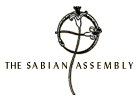
1.
The Sabian Idea
The Word Sabian
The use of the word Sabian to designate the present project was a gradual development. The author employed the term originally in his Key Truths of Occult Philosophy (Los Angeles, J. F. Rowny, 1925), to identify the fifth Atlantean subrace. By the time he came to rewrite and expand the earlier text as Occult Philosophy, a recognition of the Sumerians as typical of the racial substream seemed to promise a more helpful orientation in what still remains an almost insuperable problem of charting. In the meanwhile the first attempt at an improved patterning for the races had given the word its special association with the occult brotherhood under whose auspices the group was taking form. Its adoption as a name for the work, then fairly well in progress, was a curiously casual contribution of the students in the California classes.
There has long been a marked confusion between Sabaean and Sabian. The former identifies the star-worshipers of the ancient Near East, and may arise from Saba or Sheba. This was the kingdom made familiar to history by its queen, who visited Solomon in order to investigate the quality of his wisdom. There is a likely relationship between Sabaean and Sabaoth, or the hosts in the designation of God as Lord of Hosts. These hosts would be armies literally, but in more important and symbolical reference they were the stellar myriads that represented the powers of heaven. Sabian, which would translate roughly as Baptist, probably refers to the Gnostic Mandaeans or Observants of St. John the Baptist more commonly and improperly known as the Christians of St. John. Its significance stems from the fact that these Sabians were included with the Jews and Christians in the Koran as the three groups entitled to tolerance. In selecting his earlier term for the Atlantean subrace the author had Sabaean in mind. As it happened, the authority on which he relied at the time preferred the spelling Sabian for which there is indeed some recognition, and this accident of less than the best scholarship proved a fortuitous circumstance.
The city of Harran in Mesopotamia was a frontier place of importance long before Abraham's people stopped there and so of course before his son and grandson made the journey back to select wives of the idealized close relationship. As a seat for the worship of the moon god Sin it created an effective foundation for the Lunar Mysteries of what then was perhaps the fifteenth century, B.C., and it became a famous center of magic from the time of Alexander the Great until the coming of the Mongols in the thirteenth century A.D. In the ninth century it faced real trouble when the Caliph Mamun threatened to destroy it unless its people either embraced Islam or convinced him their beliefs and practices were entitled to toleration. On the advice of a Mohammedan jurist they identified themselves as Sabian. Nobody knew what the designation implied, despite the Koran's favorable attitude, and in consequence the Harranites were able to continue in their usual ways. Under the necessity to have a holy book, they adopted the writings of Hermes or the traditional collections of Egyptian lore, and ultimately this arbitrary ordering of their speculations must have been quite instrumental in giving European occultism its characteristic slant in the later medieval period. The city became famous as a clearinghouse for the great final flame of the Arabian enlightenment, and thus its inhabitants blessed the name they adopted and in their achievements they truly challenge the present Sabian group.

Home | About | Blue Letters | Marc Edmund Jones | Greetings from Members | MEJ Books | Contact
Copyright © 1976-2014. All rights reserved.